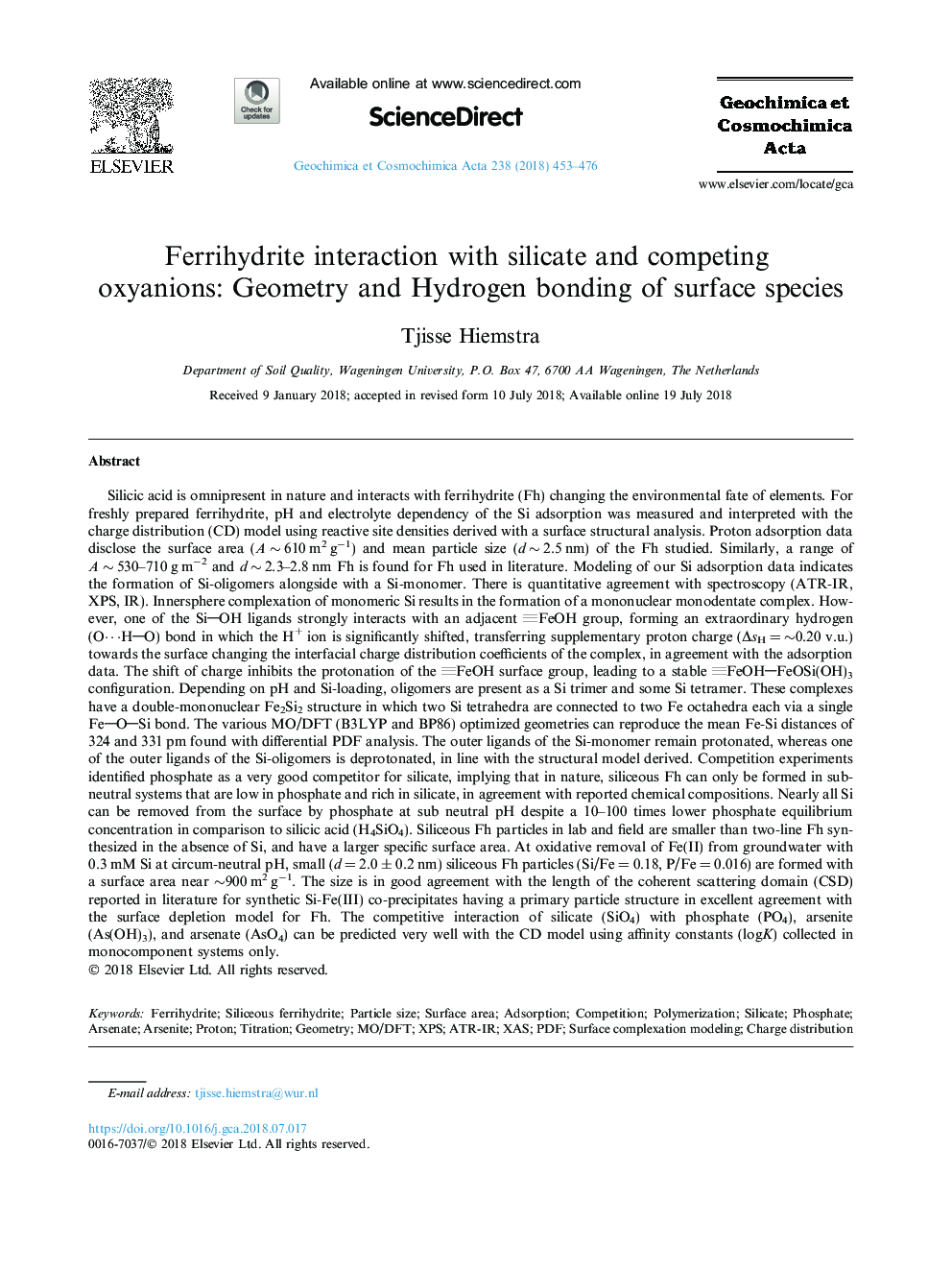| کد مقاله | کد نشریه | سال انتشار | مقاله انگلیسی | نسخه تمام متن |
|---|---|---|---|---|
| 8910612 | 1637919 | 2018 | 24 صفحه PDF | دانلود رایگان |
عنوان انگلیسی مقاله ISI
Ferrihydrite interaction with silicate and competing oxyanions: Geometry and Hydrogen bonding of surface species
ترجمه فارسی عنوان
تعامل فری هیدریت با سیلیکات و رقابت اکسیونیون: هندسه و اتصال هیدروژن از گونه های سطحی
دانلود مقاله + سفارش ترجمه
دانلود مقاله ISI انگلیسی
رایگان برای ایرانیان
کلمات کلیدی
ATR-IRXAS - HASArsenate - آرسناتarsenite - آرسنیتParticle size - اندازه ذراتCharge distribution - توزیع شارژTitration - تیتانیمAdsorption - جذبCompetition - رقابتSurface area - سطح زمینsilicate - سیلیکاتXPS - طیف نگاری فوتوالکترونی اشعه ایکسFerrihydrite - فرای هیدریدPhosphate - فسفاتSurface complexation modeling - مدل سازی مجتمع سطحGeometry - هندسهProton - پروتونPolymerization - پلیمریزاسیونPdf - پی دی اف
موضوعات مرتبط
مهندسی و علوم پایه
علوم زمین و سیارات
ژئوشیمی و پترولوژی
چکیده انگلیسی
Silicic acid is omnipresent in nature and interacts with ferrihydrite (Fh) changing the environmental fate of elements. For freshly prepared ferrihydrite, pH and electrolyte dependency of the Si adsorption was measured and interpreted with the charge distribution (CD) model using reactive site densities derived with a surface structural analysis. Proton adsorption data disclose the surface area (Aâ¯â¼â¯610â¯m2â¯gâ1) and mean particle size (dâ¯â¼â¯2.5â¯nm) of the Fh studied. Similarly, a range of Aâ¯â¼â¯530-710â¯gâ¯mâ2 and dâ¯â¼â¯2.3-2.8â¯nm Fh is found for Fh used in literature. Modeling of our Si adsorption data indicates the formation of Si-oligomers alongside with a Si-monomer. There is quantitative agreement with spectroscopy (ATR-IR, XPS, IR). Innersphere complexation of monomeric Si results in the formation of a mononuclear monodentate complex. However, one of the SiOH ligands strongly interacts with an adjacent FeOH group, forming an extraordinary hydrogen (Oâ¯HO) bond in which the H+ ion is significantly shifted, transferring supplementary proton charge (ÎsHâ¯=â¯â¼0.20 v.u.) towards the surface changing the interfacial charge distribution coefficients of the complex, in agreement with the adsorption data. The shift of charge inhibits the protonation of the FeOH surface group, leading to a stable FeOHFeOSi(OH)3 configuration. Depending on pH and Si-loading, oligomers are present as a Si trimer and some Si tetramer. These complexes have a double-mononuclear Fe2Si2 structure in which two Si tetrahedra are connected to two Fe octahedra each via a single FeOSi bond. The various MO/DFT (B3LYP and BP86) optimized geometries can reproduce the mean Fe-Si distances of 324 and 331â¯pm found with differential PDF analysis. The outer ligands of the Si-monomer remain protonated, whereas one of the outer ligands of the Si-oligomers is deprotonated, in line with the structural model derived. Competition experiments identified phosphate as a very good competitor for silicate, implying that in nature, siliceous Fh can only be formed in sub-neutral systems that are low in phosphate and rich in silicate, in agreement with reported chemical compositions. Nearly all Si can be removed from the surface by phosphate at sub neutral pH despite a 10-100 times lower phosphate equilibrium concentration in comparison to silicic acid (H4SiO4). Siliceous Fh particles in lab and field are smaller than two-line Fh synthesized in the absence of Si, and have a larger specific surface area. At oxidative removal of Fe(II) from groundwater with 0.3â¯mM Si at circum-neutral pH, small (dâ¯=â¯2.0â¯Â±â¯0.2â¯nm) siliceous Fh particles (Si/Feâ¯=â¯0.18, P/Feâ¯=â¯0.016) are formed with a surface area near â¼900â¯m2â¯gâ1. The size is in good agreement with the length of the coherent scattering domain (CSD) reported in literature for synthetic Si-Fe(III) co-precipitates having a primary particle structure in excellent agreement with the surface depletion model for Fh. The competitive interaction of silicate (SiO4) with phosphate (PO4), arsenite (As(OH)3), and arsenate (AsO4) can be predicted very well with the CD model using affinity constants (logK) collected in monocomponent systems only.
ناشر
Database: Elsevier - ScienceDirect (ساینس دایرکت)
Journal: Geochimica et Cosmochimica Acta - Volume 238, 1 October 2018, Pages 453-476
Journal: Geochimica et Cosmochimica Acta - Volume 238, 1 October 2018, Pages 453-476
نویسندگان
Tjisse Hiemstra,
